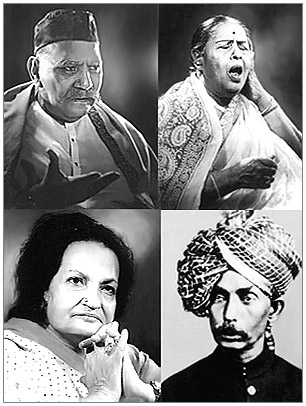 Thumri is the most important "light classical" genre of North Indian Classical music. It is performed in many contexts, from the sphere of dance, to the vocal concert stage, to performance on instruments. In eighteenth-nineteenth-century Thumri reached its zenith in Awadh. The evolution of Lucknow tradition is attributed to Prakashji who is considered as an exponent of the Rasa form. He had migrated from Allahabad and remained under patronage of Nawab Asafuddaula. Later Prakashji`s sons, Durga Prasad and Thakur Prasad became tutors of the next Nawab, Wajid Ali Shah. Durga Prasad had two sons, Kalkaji Maharaj and Binda Din Maharaj. His later son had introduced thumri to Kathak dance by composing thumris specifically as support for interpretative dance.
Thumri is the most important "light classical" genre of North Indian Classical music. It is performed in many contexts, from the sphere of dance, to the vocal concert stage, to performance on instruments. In eighteenth-nineteenth-century Thumri reached its zenith in Awadh. The evolution of Lucknow tradition is attributed to Prakashji who is considered as an exponent of the Rasa form. He had migrated from Allahabad and remained under patronage of Nawab Asafuddaula. Later Prakashji`s sons, Durga Prasad and Thakur Prasad became tutors of the next Nawab, Wajid Ali Shah. Durga Prasad had two sons, Kalkaji Maharaj and Binda Din Maharaj. His later son had introduced thumri to Kathak dance by composing thumris specifically as support for interpretative dance.
Wajid Ali Shah
Wajid Ali Shah played an important role in popularizing the kathaka-thumri renaissance. Under the guidance of Durga Prasad and Thakur Prasad, he became a formidable dancer. He was also trained by Sadiq Ali Khan and became a fine vocalist. He is credited with writing three volumes of song-texts for the thumri, dadra, khayal and sadra genres of vocal music. Wajid Ali wrote a Vaishnavite dance drama called "Indra Sabha" in Urdu, with songs in Braj bhasa. His thumri composition `babul mora naihara chuto jaye` is considered an immortal composition.
Sadiq Ali Khan
Sadiq Ali Khan born on 1800 was a vocalist who had descended from a lineage of qawwali singers. He was associated with the Khayal genre. Khan is credited with refining the bandisa thumri and laying the foundations of the bola banao thumri. Many talented musicians like Inayet Hussain Khan of Sahaswan gharana, Ramakrishna Vaze of Gwalior gharana and Bhaiyya Ganpat Rao became his disciples.
Bhaiyya Ganpat Rao
Bhaiyya Ganpat Rao of Gwalior was trained in dhrupad, khayal and the Rudra Veena. He greatly practiced the harmonium and the thumri genre. He studied thumri with Sadiq Ali Khan and Khurshid Ali Khan of Lucknow. He helped in shaping the incipient bola-banao thumri by performing it on the eminently unsuitable harmonium. Under his influence, the harmonium fast replaced the traditional sarangi as the standard melodic accompaniment for thumri. Under the pseudonym "Sughar Piya," he composed a large number of thumris, which became immensely popular. Some of the greatest thumri singers of his times were his students. Amongst them were great courtesans, Gauhar Jan, Jaddanbai, Malka Jan and male vocalists Mauzuddin Khan, Mir Irshad Ali and Babu Shyam Lai.
Jagdeep Mishra
Jagdeep Mishra of Varanasi played a similar pioneering role in the evolution of the bola-banao thumri. Mishra belonged to a family of hereditary Kathak exponents and is considered a co-founder of the Banaras bola-banao tradition.
Siddheshwari Devi
Siddheshwari Devi is also one of the outstanding semi-classical vocalists of her times. She had studied khayal and thumri with her aunt Rajeshwari Bai. The leisurely classicism of her thumri renditions brought them almost on par with the bada khayal.
Rasoolan Bai
Rasoolan Bai was a famous thumri singer. She had studied primarily with khayal vocalists, sarangi players and Kathak exponents. She was famous for her thumris, dadaras, and tappas. Her melodic range and imagination had reached great heights.
Begum Akhtar
Begum Ak]htar born in 1914 is another significant vocalist from Faizabad. She had studied Khayal with Wahid Khan, Ata Khan of Kirana Gharana, and with other Patiala maestros. She performed thumri, ghazal, dadara, and the allied folk genres. Her thumris were a blend of the Benares and Punjab styles. Her thumris were short, up to about ten minutes each. She is credited with the development of the ghazal. Akhtar enriched its melodic content enough to bring it almost on par with the bola-banao thumri.
Abdul Kareem Khan
Abdul Kareem Khan born on 1872 was the founder of the Kirana gharana of the khayala. He virtually redefined the thumri by taking the erotic, and partially the folk, out of the Benares bola-banao thumri, and replacing it with an intense poignancy and devotional fervor. He made the thumri respectable in the khayal world. The second and third generations of his lineage continued the dissemination of his style of thumri.
After Abdul Kareem Khan many other popular Thumri Singers emerged like Faiyyaz Khan of Agra Gharana, his son Sharafat Hussain, the brothers from Patiala, Bade Ghulam Ali Khan and Barkat Ali Khan. Besides Badi Motibai, Rasoolan Bai, Girija Devi, Pandit Channulal Mishra, Begum Akhtar, Shobha Gurtu, Noor Jehan, Cassius Khan and Prabha Atre were also popular thumri singers.
Other eminent khayal singers who had a flair for Thumri singing were Vilayat Hussain Khan of Agra, Mushtaq Hussain of Rampur-Sahaswan, Rehmat Khan of Gwalior and Kesarbai Kerkar of Jaipur-Atrauli.




